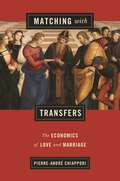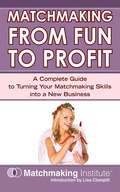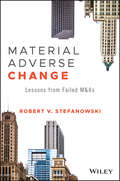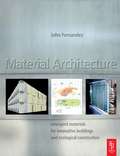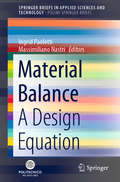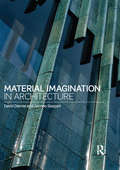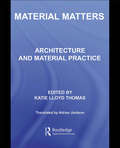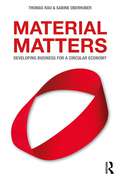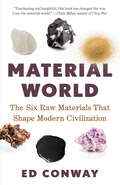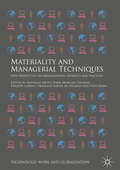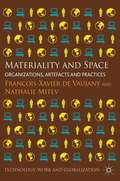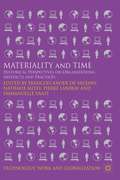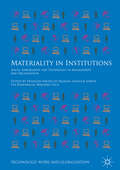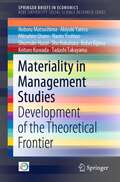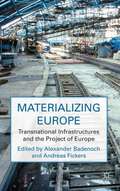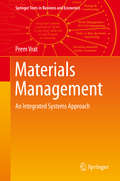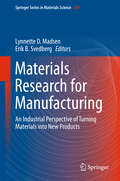- Table View
- List View
Matching Markets for Googlers
by Rembrand Koning Bo CowgillProfessor Bo Cowgill (Columbia Business School) and HBS Professor Rembrand Koning prepared this case. Professors Cowgill and Koning contributed equally to the development of this case and are listed in alphabetical order. It was reviewed and approved before publication by a company designate. Funding for the development of this case was provided by Harvard Business School and not by the company. Bo Cowgill previously worked at Google and provided advice on market design while employed there. Certain details have been disguised. HBS cases are developed solely as the basis for class discussion. Cases are not intended to serve as endorsements, sources of primary data, or illustrations of effective or ineffective management.
Matching with Transfers: The Economics of Love and Marriage
by Pierre-André ChiapporiOver the past few decades, matching models, which use mathematical frameworks to analyze allocation mechanisms for heterogeneous products and individuals, have attracted renewed attention in both theoretical and applied economics. These models have been used in many contexts, from labor markets to organ donations, but recent work has tended to focus on "nontransferable" cases rather than matching models with transfers. In this important book, Pierre-André Chiappori fills a gap in the literature by presenting a clear and elegant overview of matching with transfers and provides a set of tools that enable the analysis of matching patterns in equilibrium, as well as a series of extensions. He then applies these tools to the field of family economics and shows how analysis of matching patterns and of the incentives thus generated can contribute to our understanding of long-term economic trends, including inequality and the demand for higher education.
Matchmakers: The New Economics of Multisided Platforms
by Richard Schmalensee David S. EvansMany of the most dynamic public companies, from Alibaba to Facebook to Visa, and the most valuable start-ups, such as Airbnb and Uber, are matchmakers that connect one group of customers with another group of customers. Economists call matchmakers multisided platforms because they provide physical or virtual platforms for multiple groups to get together. Dating sites connect people with potential matches, for example, and ride-sharing apps do the same for drivers and riders. Although matchmakers have been around for millennia, they're becoming more and more popular-and profitable-due to dramatic advances in technology, and a lot of companies that have managed to crack the code of this business model have become today's power brokers.Don't let the flashy successes fool you, though. Starting a matchmaker is one of the toughest business challenges, and almost everyone who tries to build one, fails.In Matchmakers, David Evans and Richard Schmalensee, two economists who were among the first to analyze multisided platforms and discover their principles, and who've consulted for some of the most successful platform businesses in the world, explain how matchmakers work best in practice, why they do what they do, and how entrepreneurs can improve their chances for success.Whether you're an entrepreneur, an investor, a consumer, or an executive, your future will involve more and more multisided platforms, and Matchmakers-rich with stories from platform winners and losers-is the one book you'll need in order to navigate this appealing but confusing world.
Matchmaking From Fun to Profit: A Complete Guide To Turning Your Matchmaking Skills Into A New Business
by Matchmaking InstituteYou've successfully set up your friends with their perfect partners and have become the "go-to person" when pals need a new relationship. That may just seem like a fun way to help those you love, but it might be a great career opportunity, too. Don't just play matchmaker...really become one! It's simple, with this professional course created by the authorities at the Matchmaking Institute. Here are proven techniques for signing clients, interviewing effectively, getting publicity, and more. The guide walks you through the basics of starting a business, and even provides answers to commonly asked questions. So don't wait until the next time someone says, "You should do this for a living." The time to make a move is now.
Material Adverse Change: Lessons from Failed M&As (Wiley Finance)
by Robert V. StefanowskiBoost M&A outcomes with less risk by learning from mistakes of the past Material Adverse Change will help you close more successful mergers and acquisitions by analyzing the common root causes of deal failures from before the Great Recession to today. The time between signing and closing a deal is a particularly risky period where the buyer has committed to purchase the company, but the seller continues to operate it while waiting for regulatory approval or funding to close out the deal. A Material Adverse Change clause allows the buyer to back out of the transaction if certain adverse events occur during this period. By designing this safety net into the contract, you’re free to take the time to examine records, meet with employees, and fully understand the legal issues at hand. If the target loses value during that time, in certain cases, you’re free to walk away. This book explores the full power of the Material Adverse Change clause, and today’s M&A in general. You’ll dig into the real causes of M&A failure, and discover the traits and practices that lead to poor results as you learn how to avoid these common mistakes and drive more successful deals. Recent case studies highlight common mistakes made—and propagated—by otherwise intelligent people, so you can identify and eliminate these practices within your own organization. A large acquisition is already a delicate balancing act. Why complicate it with the exponential risk by not doing your homework? This book shows you how to apply best practices to increase your chances of successful deals and avoid potentially career ending mistakes. Explore the true root causes of M&A failures of the past Analyze the personality traits that drive suboptimal outcomes Implement new practices to avoid mistakes and close successful deals Learn why common-sense errors are repeated over and over again The M&A market has grown to become a major factor in the global economy, yet many buyers do less investigation than consumers making everyday purchases. Material Adverse Change shows you how to slash risk and improve your chances of completing better deals.
Material Architecture
by John FernandezComposed of a series of essays, this book deals with the broad issues affecting the nature of architectural materials and provides a focused review of the state of the art materials. It also provides designers with the tools they need to evaluate and select from the thousands of different materials that are available to them. The book is organized into three sections; ‘Time’ looks at how the materials used in architectural design have changed over the years showing how we have come to use the materials we do in contemporary design. ‘Materials’ covers all five material families; metals, polymers, ceramics, composites and natural materials giving in depth information on their properties, behavior, origins and uses in design. It also introduces a review of the cutting edge research for each family. ‘Systems’ outlines the technical design-orientated research that uncovers how new architectural assemblies can be designed and engineered. All of this practical advice is given along with many real case examples illustrating how this knowledge and information has been, and can be, used in architectural design.
Material Balance: A Design Equation (SpringerBriefs in Applied Sciences and Technology)
by Ingrid Paoletti Massimiliano NastriThis book argues that we are living in an era of deep mutation, and the anthropocentric model no longer fits our way of living and behaving on Earth. Climate change is upsetting our relationship with nature and the environment, while artificial intelligence scenarios undermine the foundations of human life. As the pressure to re-align based on new modes of living and consuming increases, the first priority should be to address the way we imagine, design, produce and construct our built environment. The highly original book explores how the relation between design technology and material cultures can underpin and drive this change. It discusses the need for a new “material balance” to develop our design practice, not only from an energy and environmental perspective, but also from a physiological, cultural and semantic one, in order to re-balance the impact of material design on society. This publication is an excellent guide to understanding in detail the theoretical framing of several crucial topics in material balance design, from computational knitting to material agency, and from new acoustic ecology to future façade technologies, bio-based design and ultimately non-anthropocentric habitats, offering insights into preferable future scenarios.
Material Imagination in Architecture
by David Dernie Jacopo GaspariMaterial Imagination in Architecture draws on history and the visual arts, and contemporary architecture to explore this popular theme in architectural practice and education. In the context of a discipline increasingly driven by digital production, this text explores architecture and making and the diverse influences on the material reality of architectural form: it argues that the crafts, fabrication and assemblage of its making remain vital elements of contemporary architectural language. This broad-ranging text bridges the gap between a technical or otherwise fragmentary knowledge of materials of the specialist, and the tacit or instinctive understanding of materials that the artist, sculptor or architect may have. It identifies key material themes pertinent to contemporary architectural debate and develops a discourse about future practice that is framed by environmental imperatives and grounded in a historical understanding of the meaning and use of materials. Material iconology in architecture is a well-established tradition and this book draws on that background to investigate the possibilities, and limits, of using materials in contemporary design to communicate the themes and contexts of an architectural project, a material’s relationship to context, and to the history of practices that belong to the traditions of making buildings. Each theme is explored in case studies from twelve countries around the world, including the UK, USA, Spain, Italy, Germany, Australia and China.
Material Matters: Architecture and Material Practice
by Katie Lloyd ThomasBringing together texts and work by theorists and practitioners who are making material central to their work, this book reflects the diverse areas of inquiry which are expanding current material discourse. Focusing on the cultural, political, economic, technological and intellectual forces which shape material practices in architecture, the contributors draw on disciplines ranging from philosophy, history and pedagogy to art practice and digital and low-tech fabrication. By paying critical attention to material, a wide range of issues emerge which are otherwise excluded from architectural discourse, issues that shape and determine the buildings we make, the processes we use and the ways we understand them. Beautifully illustrated and designed, this book is a unique collection which will be of great interest to architectural practitioners and theorists who want to consider the wider implications of material practice, and to students who are developing their own approach to making buildings.
Material Matters: Developing Business for a Circular Economy
by Thomas Rau Sabine OberhuberOur planet is a closed system with limited material resources, yet our current economic model is designed in a one-way direction from resource extraction to disposal, leading to resource depletion. This book proposes a new economic model, offering an alternative to this linear ‘take-make-waste’ economy. Material Matters shows a way of creating a circular economy by using the unlimited resources we have: renewable energy, data and intelligence. It describes a system based on circular business models centred on selling performance rather than ownership, designing products and buildings as resource banks and equipping products with a ‘material passport’ to ensure their usability for future generations. Businesses thereby become custodians of materials, rather than consumers of materials and sellers of products. The book evokes the vision of a radically new economic model based on a compelling narrative, supported with cases that have been developed in conjunction with major companies, for example, convincing Philips to sell light instead of lamps, saving energy and materials by creating a whole new business model, a case which has become iconic for the circular economy. Material Matters is not a somber analysis of the state of the planet but a concrete and comprehensive agenda for change, offering perspectives for taking action for business and individual consumers alike.
Material World: A Global Family Portrait
by Charles C. Mann Peter MenzelWe are witnessing the emergence of a unified world economy, as exemplified by NAFTA and GATT, that will, in theory, make goods available at cheaper prices, and create new jobs throughout the world.
Material World: The Six Raw Materials That Shape Modern Civilization
by Ed ConwayTHE NEW YORK TIMES BOOK REVIEW EDITORS' CHOICE • AN ECONOMIST BEST BOOK OF THE YEAR • Sand, salt, iron, copper, oil, and lithium. These fundamental materials have created empires, razed civilizations, and fed our ingenuity and greed for thousands of years. Without them, our modern world would not exist, and the battle to control them will determine our future. • Finalist for the Financial Times and Schroders Business Book of the Year AwardThe fiber-optic cables that weave the World Wide Web, the copper veins of our electric grids, the silicon chips and lithium batteries that power our phones and cars: though it can feel like we now live in a weightless world of information—what Ed Conway calls &“the ethereal world&”—our twenty-first-century lives are still very much rooted in the material.In fact, we dug more stuff out of the earth in 2017 than in all of human history before 1950. For every ton of fossil fuels, we extract six tons of other materials, from sand to stone to wood to metal. And in Material World, Conway embarks on an epic journey across continents, cultures, and epochs to reveal the underpinnings of modern life on Earth—traveling from the sweltering depths of the deepest mine in Europe to spotless silicon chip factories in Taiwan to the eerie green pools where lithium originates.Material World is a celebration of the humans and the human networks, the miraculous processes and the little-known companies, that combine to turn raw materials into things of wonder. This is the story of human civilization from an entirely new perspective: the ground up.
Materialflusssysteme: Förder- Und Lagertechnik (VDI-Buch)
by Michael Ten Hompel Thorsten Schmidt Johannes DreggerIntralogistik: lagern – transportieren - zusammenführen – verteilen. Auch die 3., völlig neu bearbeitete Auflage gibt einen grundlegenden und vollständigen Überblick über alle Komponenten zur Erfüllung zentraler logistischer Funktionen. Zahlreiche Tabellen, Grafiken und technische Daten, eine Fülle konkreter Systembeispiele und Auswahlmöglichkeiten unterstützen sowohl Studierende als auch Praktiker, Planer und Entscheider bei ihrer Arbeit.
Materiality and Managerial Techniques
by Francois-Xavier de Vaujany Nathalie Mitev Anna Morgan-Thomas Philippe Lorino Yesh NamaThis edited book examines the relationship between the materiality of artefacts and managerial techniques, combining the recent scholarly interest on socio-materiality with a focus on management. Exploring managerial techniques, the social and material tools used by actors to guide or facilitate collective activities, topics include their socio-materiality, performative dimension, role in managerial control, relationship to organisational space and relationship to organisational legitimacy. This volume particularly explores the valuation and legitimation practices or processes involving managerial techniques, their modalities, specificities and involvement in collective activity within organisations. The overall aim of the chapters is to explore in different ways and instances the way in which material artefacts are able to inscribe and enforce managerial action which affects daily work practices.
Materiality and Space
by Francois-Xavier de Vaujany Nathalie MitevMateriality and Space focuses on how organizations and managing are bound with the material forms and spaces through which humans act and interact at work. It concentrates on organizational practices and pulls together three separate domainsthat are rarely looked at together: sociomateriality, sociology of space, and social studies of technology. The contributions draw on and combine several of these domains, and propose analyses of spaces and materiality in a range of organizational practices such as collaborative workspaces, media work, urban management, e-learning environments, managerial control, mobile lives, institutional routines and professional identity. Theoretical insights are also developed by Pickering on the material world, Lyytinen on affordance, Lorino on architexture and Introna on sociomaterial assemblages in order to delve further into conceptualizing materiality in organizations. "
Materiality and Time
by Francois-Xavier de Vaujany Nathalie Mitev Pierre Laniray Emmanuelle VaastSociomaterial research overcomes the dichotomy between social and material worlds by concentrating on organizational practices. These practices are constituted by, but also produce, material and social dynamics. This research is currently having an important impact in management studies and adopts a subjective investigation of time to explore materiality and materialization. Studying the institutional evolution of an organization implies long time spans and it is shown more clearly through the inclusion of material traces of past actions. Materiality and Time is split into three parts: Part I explores how time is materialized and performed in organizations, i. e. how artefacts and material space perform time and temporal dynamics in organizations. Part II examines how organizations and organizational members are constituted by and constitutive of material artefacts. Part III reflects on what a historical perspective on these materializations can bring to the study of organizations. Contributions focus on the materialization of time and the material dynamic of organizations.
Materiality in Institutions: Spaces, Embodiment And Technology In Management And Organization (Technology, Work And Globalization Ser.)
by Bernard Leca Eva Boxenbaum François-Xavier de Vaujany Anouck AdrotThis book aims at clarifying the role of materiality, spaces, digitality and embodiment in institutional dynamics from the perspective of Management & Organization Studies. Presenting a rich set of theoretical, methodological and epistemological advances on materiality and institutions, it also gives voice to distinctive and diverse perspectives on materiality in institutions, structuring chapters into four major topics: artefacts and objects, digitality and information, space and time, body and embodiment. This book sparks discussion and debate about ontological dimensions of Management & Organization Studies, including post-discursive, visual, phenomenological and material.
Materiality in Management Studies: Development of the Theoretical Frontier (SpringerBriefs in Economics)
by Noboru Matsushima Akiyuki Yatera Mitsuhiro Urano Naoto Yoshino Shunsuke Hazui Sho Nakahara Kohei Kijima Keitaro Kuwada Tadashi TakayamaThe book systematizes the materiality concept, which has been fragmented in various fields of business administration and sometimes identified with interpretive postmodern business administration, along with the meta-theories discussed in the humanities and social sciences that aim to overcome humanistic dualism. This book is devoted to developing the concept of materiality as the theoretical frontier that has not been fully addressed in management studies, ranging from daily work practices in office spaces to the manualization of high-tech aircraft maintenance, to quantified personnel evaluations and fuel efficiency standards, to innovation using advanced scientific equipment. Institutional organization theory focuses on the material on which the symbolism of institutions is inscribed. Organizational routine research seeks to unravel the material dimension of organizational performative practices. Organizational wrongdoing research critiques material measurement practice based on social constructionism. Critical management studies focus on the material space as a way to counter the humanistic concept of time. Science-based innovation challenges sociomaterialistic science practices that originate from devices for management of technology (MOT) that have not been able to penetrate into the workings of science and technology, actually. Up-and-coming researchers in Japanese management studies conduct empirical research that draws out the implications of the concept of materiality.
Materiality, Rules and Regulation: New Trends in Management and Organization Studies (Technology, Work and Globalization)
by Nathalie Mitev François-Xavier de Vaujany Anouk Mukherjee Giovan LanzaraMateriality, Rules and Regulation: New Trend in Management and Organization Studies concentrates on the relationship of rules and regulation to the materiality of artefacts, practices, and organizations. It combines the recent scholarly interest on sociomateriality with a focus on regulation and rules.
Materializing Europe: Transnational Infrastructures and the Project of Europe
by Alexander Badenoch Andreas FickersThis book explores the relationships between European integration and material infrastructures. Taking transnational infrastructures as the focal point of study, the book focuses on the various forms of mediation between the material, institutional and discursive levels of European integration and fragmentation in a truly transnational perspective.
Materials Management
by Prem VratThis book examines the problem of managing the flow of materials into, through, and out of a system in order to improve the efficiency and effectiveness of materials management. The subject is crucial for global competitive advantage, as materials constitute the largest single cost factor in manufacturing and service, and their effective management enhances value for money. In this context, inventory is a barometer of materials management effectiveness, along with wastage of materials. The book adopts a comprehensive, integrated systems approach and covers almost all aspects of materials, considering the specification, procurement, storage, handling, issue, use and accounting of materials to get the most out of every dollar invested. Combining conceptual clarity and quantitative rigor, it will be a highly useful guide for practicing managers, academics and researchers in this vital functional area.
Materials Management
by Stan C. McdonaldA solid introduction to materials management and the tools needed to create a world-class materials management programThis nuts-and-bolts guide presents an overview of the inner workings of the materials process, as well as the best practices to achieve a world-class operating system that will help to eliminate ineffective materials management. Coverage includes discussion of material requirements planning, planning parameters, electronic data interchange, and material control graphs and reports, among many other topics. Thorough and practical, Materials Management explains the impact that inadequate inventory control has on a company and how these poor controls can reduce production, cause inefficiencies in labor, create excessive inventory, and increase freight expenses.Stan McDonald (Northville, MI) is an independent consultant on materials management. Throughout his 30-year career, he has held various positions in the supply chain/materials management arena.
Materials Parsimony: Using Nature's Rules to Reduce Your Materials Palette, Increase Your Productivity, and Reduce Risk
by Gregory C. UnruhAs the public increasingly holds brand owners responsible for what goes into their products, you may be realizing you have only a limited understanding of the materials - and risks - you are putting into your products. In contrast, nature has none of these problems, manufacturing all its products using an incredibly small number of fundamental and, by necessity, nontoxic materials. This chapter gives you the practical tools you need to begin to shift your company's material selection process toward the model of perfect efficiency that the biosphere provides. By using the biosphere's first rule of "materials parsimony," your business will build not just a sustainable materials palette but ultimately, renewable value cycles. Through real-life success stories and cautionary tales, you will learn how a "green screen" can help move your business beyond risk management and toxin screening to reducing supplier complexity, improving worker productivity, and reducing production complexity. This chapter was originally published as Chapter 1 of "Earth, Inc.: Using Nature's Rules to Build Sustainable Profits."
Materials Research for Manufacturing
by Lynnette D. Madsen Erik B. SvedbergThis book is about applied materials research in industry. It presents various important topics and challenges and gives guidance to materials researchers who move to industry. The book focuses on the materials manufacturing issues for industrial application. It deals with developments and challenges in traditional materials areas, such as metals and ceramics, and new opportunities that have risen from nanotechnology and additive manufacturing. The chapters, written by senior people from large companies, include successful manufacturing undertakings, several distinct and unresolved manufacturing challenges, with the focus on approaches, timelines and the skills needed for future company research and development. The book provides a cross-section of current and future approaches valuable for new employees and academics working in industry.

